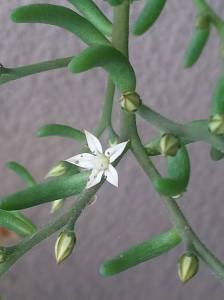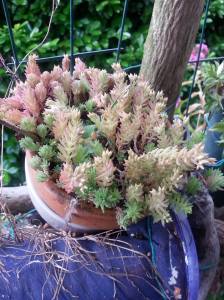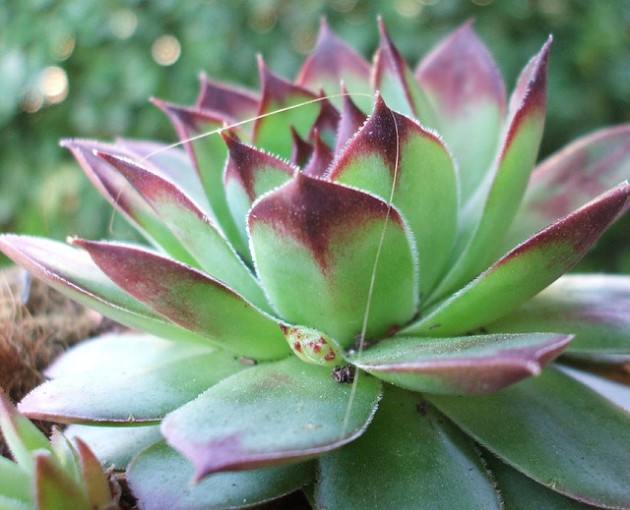Not to be confused with cactus; botanically cacti are succulents but not all succulents are cacti. Succulent plants, such as this Aloe, store water in their fleshy leaves
In botany, succulent plants, also known as succulents or sometimes fat plants, are plants having some parts that are more than normally thickened and fleshy, usually to retain water in arid climates or soil conditions. Succulent plants may store water in various structures, such as leaves and stems. Some definitions also include roots, so that geophytes that survive unfavorable periods by dying back to underground storage organs may be regarded as succulents. In horticultural use, the term “succulent” is often used in a way which excludes plants that botanists would regard as succulents, such as cacti. Succulents are grown as ornamental plants because of their striking and unusual appearance.
Definition
There are a number of somewhat different definitions of the term succulent. One difference lies in whether or not roots are included in the parts of a plant which make it a succulent. Some authors include roots, as in the definition “plants in which the leaves, stem or roots have become more than usually fleshy by the development of water-storing tissue.” Others exclude roots, as in the definition “a plant with thick, fleshy and swollen stems and/or leaves, adapted to dry environments”. This difference affects the relationship between succulents and “geophytes” – plants that survive unfavorable seasons as a resting bud on an underground organ. These underground organs, such as bulbs, corms and tubers, are often fleshy with water-storing tissues. Thus if roots are included in the definition, many geophytes would be classed as succulents.
Plants adapted to living in dry environments are termed xerophytes; thus succulents are often xerophytes. However, not all xerophytes are succulents, since there are other ways of adapting to a shortage of water, e.g. by developing small leaves which may roll up or having leathery rather than succulent leaves. Nor are all succulents xerophytes, since plants like Crassula helmsii are both succulent and aquatic.
Those who grow succulents as a hobby use the term in a different way to botanists. In horticultural use, the term succulent regularly excludes cacti. For example, Jacobsen’s three volume Handbook of Succulent Plants does not cover cacti, and “cacti and succulents” is the title or part of the title of many books covering the cultivation of these plants. However, in botanical terminology, cacti are succulents. Horticulturists may also exclude other groups of plants, e.g. bromeliads. A practical, but unscientific, horticultural definition is “a succulent plant is any desert plant that a succulent plant collector wishes to grow”. Such plants less often include geophytes (in which the swollen storage organ is wholly underground) but do include plants with a caudex, which is a swollen above-ground organ at soil level, formed from a stem, a root or both.
A further difficulty is that plants are not either succulent or non-succulent. In many genera and families there is a continuous sequence from plants with thin leaves and normal stems to those with very clearly thickened and fleshy leaves or stems, so that deciding what is a succulent is often arbitrary. Different sources may classify the same plant differently.
Appearance
The storage of water often gives succulent plants a more swollen or fleshy appearance than other plants, a characteristic known as succulence. In addition to succulence, succulent plants variously have other water-saving features. These may include:
- Crassulacean acid metabolism (CAM) to minimize water loss
- absent, reduced, or cylindrical-to-spherical leaves
- reduction in the number of stomata
- stems as the main site of photosynthesis, rather than leaves
- compact, reduced, cushion-like, columnar, or spherical growth form
- ribs enabling rapid increases in plant volume and decreasing surface area exposed to the sun
- waxy, hairy, or spiny outer surface to create a humid micro-habitat around the plant, which reduces air movement near the surface of the plant, and thereby reduces water loss and creates shade
- roots very near the surface of the soil, so they are able to take up moisture from very small showers or even from heavy dew
- ability to remain plump and full of water even with high internal temperatures (e.g. 52 °C or 126 °F)
- very impervious outer cuticle (skin)
- mucilaginous substances, which retain water abundantly
Habitat
Many succulents come from the dry areas of the tropics and subtropics, such as steppes, semi-desert, and desert. High temperatures and low precipitation force plants to collect and store water to survive long dry periods. Succulents may occasionally occur as epiphytes – “air plants” – as they have limited or no contact with the ground, and are dependent on their ability to store water and gain nutrients by other means; this niche is seen in Tillandsia. Succulents also occur as inhabitants of sea coasts and dry lakes, which are exposed to high levels of dissolved minerals that are deadly to many other plant species.
 Evolution
Evolution
The best-known succulents are cacti (family: Cactaceae). Virtually all cacti are succulents, but not all succulents are cacti. A unique feature of cacti is the possession of areoles, structures from which spines and flowers are produced.
To differentiate between these two basic types that seem so similar, but that are unrelated succulent plants, use of the terms, cactus or cacti, only should be used to describe succulents in the cactus family. Popular collection of these types of plants has led to many Old World plants becoming established in the wild in the New World, and vice versa.
Plant families and genera in which succulent species occur are listed below.
Order Alismatales
Order Apiales
Order Asparagales
- Amaryllidaceae (geophytes): Ammocharis, Apodolirion, Boophone, Brunsvigia, Crinum, Crossyne, Cryptostephanus, Cyrtanthus, Gethyllis, Habranthus, Haemanthus, Hessea, Nerine, Pancratium, Rauhia, Scadoxus, Strumaria, Zephyranthes,
- Asparagaceae
- subfamily Agavoideae: Agave, Beschorneria, Chlorophytum, Furcraea, Hesperaloe, Hesperoyucca, Yucca
- subfamily Asparagoideae: Asparagus
- subfamily Lomandroideae: Cordyline,
- subfamily Nolinoideae: Beaucarnea, Calibanus, Dasylirion, Dracaena, Nolina, Sansevieria, Eriospermum
- subfamily Scilloideae: Albuca, Bowiea, Daubenya, Dipcadi, Drimia, Drimiopsis, Eucomis, Hyacinthus, Lachenalia, Ledebouria, Litanthus, Massonia, Merwilla, Namophila, Ornithogalum, Pseudogaltonia, Pseudoprospero, Resnova, Schizobasis, Schizocarphus, Spetaea, Veltheimia
- Iridaceae (geophytes): Babiana, Chasmanthe, Crocosmia, Devia, Dierama, Dietes, Duthiastrum, Ferraria, Freesia, Geissorhiza, Gladiolus, Hesperantha, Ixia, Lapeirousia, Melasphaerula, Micranthus, Moraea, Pillansia, Radinosiphon, Romulea, Sparaxis, Syringodea, Thereianthus, Tritonia, Tritoniopsis, Watsonia, Xenoscapa
- Orchidaceae (succulents) Acampe, Aerangis, Ansellia, Bolusiella, Bulbophyllum, Calanthe, Cyrtorchis, Oberonia, Polystachya, Tridactyle, Vanilla
-
- (succulent geophytes) Eulophia, Liparis, Oeceoclades
- (geophytes) Acroliphia, Bartholina, Bonatea, Brachycorythis, Brownleea, Centrostigma, Ceratandra, Corycium, Cynorkis, Didymoplexis, Disa, Disperis, Dracomonticola, Eulophia, Evotella, Gastrodia, Habernaria, Holothrix, Huttonaea, Neobolusia, Nervilia, Plicosepalus, Pachites, Platycoryne
-
- subfamily Epidendroideae Phalaenopsis
- Xanthorrhoeaceae
- subfamily Asphodeloideae: Aloe (succulents and succulent geophytes), Astroloba, × Astroworthia, Bulbine (succulent geophytes, succulents, and geophytes), Bulbinella (geophyte), Chortolirion (succulent geophytes), Gasteria, Haworthia, Trachyandra (succulent geophytes and succulents),
- subfamily Xanothorrhoeoidae: Xanthorrhoea
Order Asterales
- Asteraceae: Arctotheca, Baeriopsis, Chrysanthemoides, Coulterella, Crassocephalum, Didelta, Emilia, Eremothamnus, Gymnodiscus, Gynura, Hillardiella (geophyte), Lopholaena, Monoculus, Nidorella, Osteospermum, Othonna (succulents and succulent geophytes), Phaneroglossa, Poecilolepis, Polyachyrus, Pteronia, Senecio, Solanecio,Tripteris
Order Brassicales
Order Caryophyllales
- Aizoaceae: Corbichonia, Gisekia, Herreanthus, Limeum, Ophthalmophyllum, Saphesia
- subfamily Aizooideae: Acrosanthes, Aizoanthemum, Aizoon, Galenia, Gunniopsis, Plinthus, Tetragonia
- subfamily Mesembryanthemoideae (syn. Mesembryanthemaceae[15]): Aptenia, Aridaria, Aspazoma, Brownanthus, Calamophyllum, Caulipsilon, Conophytum, Dactylopsis, Erepsia, Hameria, Hartmanthus, Hymenogyne, Marlothistela, Mesembryanthemum, Phiambolia, Phyllobolus, Prenia, Psilocaulon, Ruschiella, Sarozona, Sceletium, Synaptophyllum
- subfamily Ruschioideae:
- tribe Apatesieae: Apatesia, Carpanthea, Caryotophora, Conicosia, Hymenogyne, Saphesia, Skiatophytum
- tribe Dorotheantheae: Aethephyllum Cleretum Dorotheanthus
- tribe Ruschiae: Acrodon, Aloinopsis, Amphibolia, Antegibbaeum, Antimima, Arenifera, Argyroderma, Astridia, Bergeranthus, Bijlia, Braunsia, Brianhuntleya, Carpobrotus, Carruanthus, Cephalophyllum, Cerochlamys, Chasmatophyllum, Cheiridopsis, Circandra, Conophytum, Corpuscularia, Cylindrophyllum, Delosperma, Dicrocaulon, Didymaotus, Dinteranthus, Diplosoma, Disphyma, Dracophilus, Drosanthemum, Eberlanzia, Ebracteola, Enarganthe, Erepsia, Esterhuysenia, Faucaria, Fenestraria, Frithia, Gibbaeum, Glottiphyllum, Hallianthus, Hereroa, Ihlenfeldtia, Imitaria, Jacobsenia, Jensenobotrya, Jordaaniella, Juttadinteria, Khadia, Lampranthus, Lapidaria (plant), Leipoldtia, Lithops, Machairophyllum, Malephora, Mestoklema, Meyerophytum, Mitrophyllum, Monilaria, Mossia, Muiria, Namaquanthus, Namibia, Nananthus, Nelia, Neohenricia, Octopoma, Odontophorus, Oophytum, Ophthalmophyllum, Orthopterum, Oscularia, Ottosonderia, Pleiospilos, Polymita, Psammophora, Rabiea, Rhinephyllum, Rhombophyllum, Ruschia, Ruschianthemum, Ruschianthus, Schlechteranthus, Schwantesia, Scopelogena, Smicrostigma, Stayneria, Stoeberia, Stomatium Tanquana Titanopsis, Trichodiadema, Vanheerdea, Vanzijlia, Vlokia, Wooleya, Zeuktophyllum
- subfamily Sesuvioideae: Cypselea, Sesuvium, Trianthema, Tribulocarpus, Zaleya
- Amaranthaceae:
- subfamily Amaranthoideae: Arthraerva
- subfamily Chenopodioideae (family Chenopodiaceae):[16]) Atriplex, Chenopodium, Dissocarpus, Einadia, Enchylaena, Eremophea, Halopeplis, Maireana, Malacocera, Neobassia, Osteocarpum, Rhagodia, Roycea, Halosarcia, Salicornia, Salsola, Sarcocornia, Sclerochlamys, Sclerolaena, Suaeda, Tecticornia, Threlkeldia
- Cactaceae: Acanthocalycium, Acanthocereus, Ariocarpus, Armatocereus, Arrojadoa, Arthrocereus, Astrophytum, Austrocactus, Aztekium, Bergerocactus, Blossfeldia, Brachycereus, Browningia, Brasilicereus, Calymmanthium, Carnegiea, Cephalocereus, Cephalocleistocactus, Cereus, Cintia, Cipocereus, Cleistocactus, Coleocephalocereus, Copiapoa, Corryocactus, Coryphantha, Dendrocereus, Denmoza, Discocactus, Disocactus, Echinocactus, Echinocereus, Echinopsis, Epiphyllum, Epithelantha, Eriosyce, Escobaria, Escontria, Espostoa, Espostoopsis, Eulychnia, Facheiroa, Ferocactus, Frailea, Geohintonia, Gymnocalycium, Haageocereus, Harrisia, Hatiora, Hylocereus, Jasminocereus, Lasiocereus, Leocereus, Lepismium, Leptocereus, Leuchtenbergia, Lophophora, Maihuenia, Malacocarpus, Mammillaria, Mammilloydia, Matucana, Melocactus, Micranthocereus, Mila, Monvillea, Myrtillocactus, Neobuxbaumia, Neolloydia, Neoraimondia, Neowerdermannia, Obregonia, Opuntia, Oreocereus, Oroya, Ortegocactus, Pachycereus, Parodia, Pediocactus, Pelecyphora, Peniocereus, Pereskia, Pereskiopsis, Pilosocereus, Polaskia, Praecereus, Pseudoacanthocereus, Pseudorhipsalis, Pterocactus, Pygmaeocereus, Quiabentia, Rauhocereus, Rebutia, Rhipsalis, Samaipaticereus, Schlumbergera, Sclerocactus, Selenicereus, Stenocactus, Stenocereus, Stephanocereus, Stetsonia, Strombocactus, Tacinga, Thelocactus,Trichocereus Turbinicarpus, Uebelmannia, Weberbauerocereus, Weberocereus, Yungasocereus
- Portulacaceae: Amphipetalum, Anacampseros, Avonia, Calyptrotheca, Ceraria, Cistanthe, Calandrinia, Dendroportulaca, Grahamia, Lewisia, Parakeelya,[17] Portulaca, Portulacaria, Schreiteria, Talinella, Talinum
Order Commelinales
Order Cornales
Order Cucurbitales
- Cucurbitaceae: Acanthosicyos, Apodanthera, Brandegea, Cephalopentandra, Ceratosanthes, Citrullus, Coccinia, Corallocarpus, Cucumella, Cucumis, Cucurbita, Cyclantheropsis, Dactyliandra, Dendrosicyos, Doyera, Eureindra, Fevillea, Gerrandanthus, Gynostemma, Halosicyos, Ibervilla, Kedostris, Lagenaria, Marah, Momordica, Neoalsomitra, Odosicyos, Parasicyos, Syrigia, Telfairia, Trochomeria, Trochomeriopsis, Tumamoca, Xerosicyos, Zehneria, Zygosicyos
Order Diascoreales
Order Ericales
Order Fabales
Order Gentianales
- Apocynaceae: Adenium, Mandevilla, Pachypodium, Plumeria
- subfamily Asclepiadoideae (syn. Asclepiadaceae): Absolmsia, Australluma, Aspidoglossum, Aspidonepsis, Baynesia, Brachystelma, Ceropegia, Chlorocyathus, Cibirhiza, Cordylogyne, Cynanchum, Dischidia, Dischidiopsis, Duvaliandra, Eustegia, Fanninia, Fockea, Glossostelma, Hoya, Ischnolepis, Lavrania, Marsdenia, Miraglossum, Odontostelma, Ophionella, Orbeanthus, Pachycarpus, Parapodium, Periglossum, Petopentia, Raphionacme, Riocreuxia, Sarcorrhiza, Schizoglossum, Schlechterella, Stathmostelma, Stenostelma, Stomatostemma, Trachycalymma, Trichocaulon, Tylophora, Woodia, Xysmalobium
- tribe Asclepiadeae:
- subtribe Asclepiadne: Asclepias,
- subtribe Cynanchinae: Sarcostemma,
- subtribe Gonolobinae: Matelea,
- tribe Maxillarieae:
- subtribe Lycastinae: Rudolfiella
- tribe Stapeliae: Angolluma, Caralluma, Desmidorchis, Duvalia, Echidnopsis, Edithcolea, Frerea, Hoodia, Huernia, Huerniopsis, Larryleachia, Notechidnopsis, Orbea (plant), Orbeopsis, Piaranthus, Pachycymbium, Pectinaria, Pseudolithos, Pseudopectinaria, Quaqua, Rhytidocaulon, Stapelia, Stapelianthus, Stapeliopsis, Tavaresia, Tridentea, Tromotriche, Whitesloanea
- tribe Asclepiadeae:
- subfamily Periplocoideae:
- tribe Cryptolepideae: Cryptolepis
- subfamily Asclepiadoideae (syn. Asclepiadaceae): Absolmsia, Australluma, Aspidoglossum, Aspidonepsis, Baynesia, Brachystelma, Ceropegia, Chlorocyathus, Cibirhiza, Cordylogyne, Cynanchum, Dischidia, Dischidiopsis, Duvaliandra, Eustegia, Fanninia, Fockea, Glossostelma, Hoya, Ischnolepis, Lavrania, Marsdenia, Miraglossum, Odontostelma, Ophionella, Orbeanthus, Pachycarpus, Parapodium, Periglossum, Petopentia, Raphionacme, Riocreuxia, Sarcorrhiza, Schizoglossum, Schlechterella, Stathmostelma, Stenostelma, Stomatostemma, Trachycalymma, Trichocaulon, Tylophora, Woodia, Xysmalobium
- Rubiaceae: Anthorrhiza, Anthospermum, Hydnophytum, Hydrophylax, Myrmecodia, Myrmephytum, Phylohydrax, Squamellaria
Order Geraniales
- Geraniaceae: Monsonia, Pelargonium (succulents and geophytes), Sarcocaulon
Order Lamiales
- Gesneriaceae: Aeschynanthus, Alsobia, Chirita, Codonanthe, Columnea, Nematanthus, Sinningia, Streptocarpus
- Lamiaceae: Aeollanthus, Dauphinea, Perrierastrum, Plectranthus, Rotheca, Solenostemon, Tetradenia, Thorncroftia
Order Malpighiales
Order Malvales
-
- subgroup Sterculiaceae: Brachychiton, Sterculia
Order Myrtales
Order Oxalidales
- Oxalidaceae (geophytes): Oxalis
Order Piperales
Order Poales
- Bromeliaceae: Abromeitiella, Aechmea, Ananas, Catopsis, Connellia, Dyckia, Hechtia, Neoregelia, Puya, Tillandsia, Vriesea
Order Ranunculales
Order Rosales
Order Santalales
- Loranthaceae: Actinanthella, Agelanthus, Erianthemum, Helixanthera, Moquiniella, Oncocalyx, Pedistylis, Plicosepalus, Septulina, Tapinanthus, Vanwykia
- Viscaceae(syn. Santalaceae): Viscum
Order Sapindales
Order Saxifragales
- Crassulaceae: Adromischus, Aeonium, Afrovivella, Aichryson, Bryophyllum, Cotyledon, Crassula, Cremnophila, × Cremnosedum, Dudleya, Echeveria, Graptopetalum, Greenovia, Hylotelephium, Hypagophytum, Jovibarba, Kalanchoe, Lenophyllum, Meterostachys, Monanthes, Orostachys, Pachyphytum, Perrierosedum, Phedimus, Pistorinia, Prometheum, Pseudosedum, Rhodiola, Rosularia, Sedella, Sedum, Sempervivum, Sinocrassula, Thompsonella, Tylecodon, Umbilicus, Villadia
Order Solanales
Order Vitales
Order Zygophyllales
(unplaced order)* Boraginaceae: Heliotropium (unplaced order)* Icacinaceae: Pyrenacantha (geophyte)
For some families and subfamilies, most members are succulent; for example the Cactaceae, Agavoideae, Aizoaceae, and Crassulaceae.
The table below shows the number of succulent species found in some families:
| Family or subfamily | Succulent # | Modified parts | Distribution |
|---|---|---|---|
| Agavoideae | 300 | Leaf | North and Central America |
| Cactaceae | 1600 | Stem (root, leaf) | The Americas |
| Crassulaceae | 1300 | Leaf (root) | Worldwide |
| Aizoaceae | 2000 | Leaf | Southern Africa, Australia |
| Apocynaceae | 500 | Stem | Africa, Arabia, India, Australia |
| Didiereaceae | 11 | Stem | Madagascar (endemic) |
| Euphorbiaceae | > 1000 | Stem and/or leaf and/or root | Australia, Africa, Madagascar, Asia, the Americas, Europe |
| Xanthorrhoeaceae | 500+ | Leaf | Africa, Madagascar, Australia |
| Portulacaceae | ? | Leaf and stem | The Americas, Australia, Africa |


![20170123050651-f09370cbed.[gif-2-mp4.com] 20170123050651-f09370cbed.[gif-2-mp4.com]](https://live.staticflickr.com/428/32472212275_9af8805d25_m.jpg)


